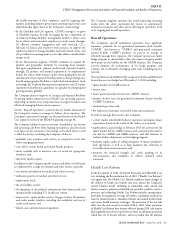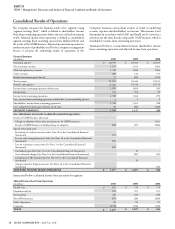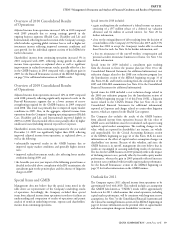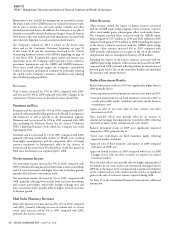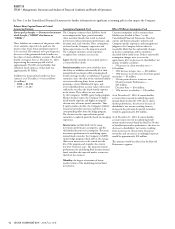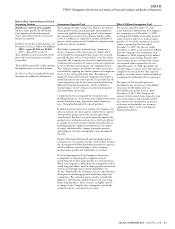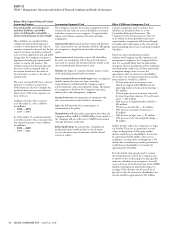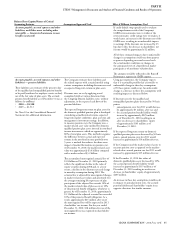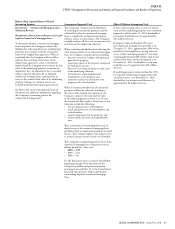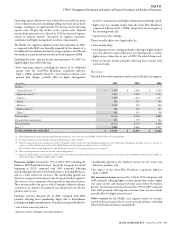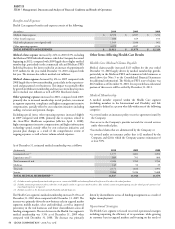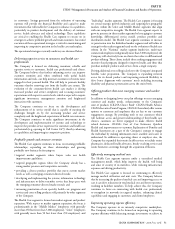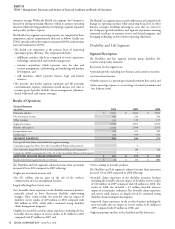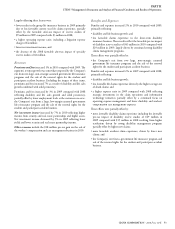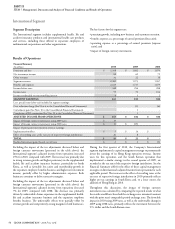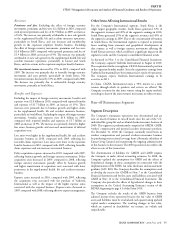Cigna 2010 Annual Report Download - page 65
Download and view the complete annual report
Please find page 65 of the 2010 Cigna annual report below. You can navigate through the pages in the report by either clicking on the pages listed below, or by using the keyword search tool below to find specific information within the annual report.
CIGNA CORPORATION 2010 Form 10K 45
PART II
ITEM 7 Management’s Discussion and Analysis of Financial Condition and Results of Operations
Balance Sheet Caption/Nature of Critical
Accounting Estimate Assumptions/Approach Used E ect if Di erent Assumptions Used
Accounts payable, accrued expenses and other
liabilities, and Other assets including other
intangibles — Guaranteed minimum income
benefi ts (continued)
If credit default swap spreads used to evaluate
the nonperformance risk of the Company’s
GMIB retrocessionaires were to widen or the
retrocessionaires’ credit ratings were to weaken, it
would cause an increase in the discount rate of the
GMIB asset, resulting in an unfavorable impact
to earnings. If the discount rate increased by 25
bps due to this, the decrease in shareholders’ net
income would be approximately $2 million.
All of these estimated impacts due to unfavorable
changes in assumptions could vary from quarter
to quarter depending on actual reserve levels,
the actual market conditions or changes in
the anticipated view of a hypothetical market
participant as of any future valuation date.
e amounts would be refl ected in the Run-off
Reinsurance segment in GMIB expense.
Accounts payable, accrued expenses and other
liabilities — pension liabilities
ese liabilities are estimates of the present value
of the qualifi ed and nonqualifi ed pension benefi ts
to be paid (attributed to employee service to date)
net of the fair value of plan assets. e accrued
pension benefi t liability as of December 31 was as
follows (in millions):
•2010— $1,528
•2009 — $1,513
See Note 10 to the Consolidated Financial
Statements for additional information.
e Company estimates these liabilities and
the related expense with actuarial models using
various assumptions including discount rates and
an expected long-term return on plan assets.
Discount rates are set by applying actual
annualized yields at various durations from
the Citigroup Pension Liability curve, without
adjustment, to the expected cash fl ows of the
pension liabilities.
e expected long-term return on plan assets for
the domestic qualifi ed pension plan is developed
considering actual historical returns, expected
long-term market conditions, plan asset mix and
management’s investment strategy. In addition,
to measure pension costs the Company uses a
market-related asset value method for domestic
qualifi ed pension plan assets invested in non-fi xed
income investments, which are approximately
80% of total plan assets. is method recognizes
the diff erence between actual and expected
returns in the non-fi xed income portfolio over
5 years, a method that reduces the short-term
impact of market fl uctuations on pension cost.
At December 31, 2010, the market-related asset
value was approximately $3.4 billion compared
with a market value of $3.2 billion.
e accumulated unrecognized actuarial loss of
$1.8 billion at December 31, 2010 primarily
refl ects the signifi cant decline in the value of
equity securities during 2008 and, to a lesser
extent, a decline in the discount rate and change
in mortality assumption during 2010. e
actuarial loss is adjusted for unrecognized changes
in market-related asset values and amortized over
the average remaining life expectancy of plan
participants if the adjusted loss exceeds 10% of
the market-related value of plan assets or 10%
of the projected benefi t obligation, whichever is
greater. As of December 31, 2010, approximately
$1.1 billion of the adjusted actuarial loss exceeded
10% of the projected benefi t obligation. As a
result, approximately $25 million after-tax of
the unrecognized loss will be expensed in 2011
shareholders’ net income. For the year ended
December 31, 2010, $18 million after-tax of the
unrecognized loss was expensed in shareholders’
net income.
Using past experience, the Company expects
that it is reasonably possible that a favorable or
unfavorable change in these key assumptions
of 50 basis points could occur. An unfavorable
change is a decrease in these key assumptions with
resulting impacts as discussed below.
If discount rates for the qualifi ed and
nonqualifi ed pension plans decreased by 50 basis
points:
• annual pension costs for 2011 would decrease
by approximately $3 million, after-tax; and
• the accrued pension benefi t liability would
increase by approximately $225 million
as of December 31, 2010 resulting in an
after-tax decrease to shareholders’ equity
of approximately $145 million as of
December 31, 2010.
If the expected long-term return on domestic
qualifi ed pension plan assets decreased by 50 basis
points, annual pension costs for 2011 would
increase by approximately $10 million after-tax.
If the Company used the market value of assets to
measure pension costs as opposed to the market-
related value, annual pension cost for 2011 would
increase by approximately $15 million after-tax.
If the December 31, 2010 fair values of
domestic qualifi ed plan assets decreased by 10%,
the accrued pension benefi t liability would
increase by approximately $315 million as of
December 31, 2010 resulting in an after-tax
decrease to shareholders’ equity of approximately
$205 million.
An increase in these key assumptions would result
in impacts to annual pension costs, the accrued
pension liability and shareholders’ equity in an
opposite direction, but similar amounts.


